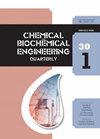Model-based Optimization of Biopolymer Production from Glycerol
IF 0.9
4区 生物学
Q4 BIOTECHNOLOGY & APPLIED MICROBIOLOGY
引用次数: 0
Abstract
The present study focuses on sustainable production of biodegradable polymers by Cupriavidus necator DSMZ 545 using glycerol as substrate. The batch growth and biopolymer production kinetics were established in a 7-L bioreactor, which resulted in a total biomass of 8.88 g L–1 and poly(3-hydroxybutyrate) (PHB) accumulation of 6.76 g L–1. The batch kinetic and independently acquired substrate inhibition data were then used to develop a mathematical model for PHB production process. This was eventually used to design different nutrient feeding strategies under constant feed rate, decreasing feed rate, and pseudo steady state of substrate (glycerol) to optimize the PHB production during fed-batch cultivation. Among all the fed-batch cultivation strategies, the highest PHB accumulation and productivity of 13.12 g L–1 and 0.27 g L–1 h–1, respectively, was achieved in fed-batch bioreactor cultivation where a pseudo steady state with respect to glycerol was maintained.甘油生产生物聚合物的模型优化
本文主要研究了以甘油为底物,利用Cupriavidus necator DSMZ 545可持续生产生物可降解聚合物。在7-L的生物反应器中建立了间歇生长和生物聚合物生产动力学,总生物量为8.88 g L-1,聚(3-羟基丁酸酯)(PHB)积累量为6.76 g L-1。然后利用间歇动力学和独立获得的底物抑制数据建立了PHB生产过程的数学模型。最终设计了定投喂率、降低投喂率和底物(甘油)伪稳态下的不同营养投料策略,以优化分批投料培养过程中PHB的产量。在所有补料间歇培养策略中,PHB积累量和生产力最高的是补料间歇生物反应器培养,分别为13.12 g L-1和0.27 g L-1 h-1,并保持甘油的准稳态。
本文章由计算机程序翻译,如有差异,请以英文原文为准。
求助全文
约1分钟内获得全文
求助全文
来源期刊
CiteScore
2.70
自引率
6.70%
发文量
23
审稿时长
>12 weeks
期刊介绍:
The journal provides an international forum for presentation of original papers, reviews and discussions on the latest developments in chemical and biochemical engineering. The scope of the journal is wide and no limitation except relevance to chemical and biochemical engineering is required.
The criteria for the acceptance of papers are originality, quality of work and clarity of style. All papers are subject to reviewing by at least two international experts (blind peer review).
The language of the journal is English. Final versions of the manuscripts are subject to metric (SI units and IUPAC recommendations) and English language reviewing.
Editor and Editorial board make the final decision about acceptance of a manuscript.
Page charges are excluded.

 求助内容:
求助内容: 应助结果提醒方式:
应助结果提醒方式:


